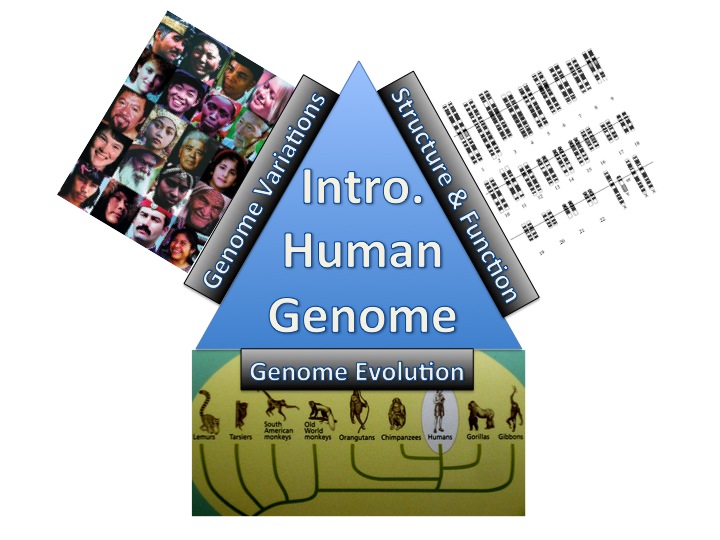Intro Genome Bio 2013
Jump to navigation
Jump to search
General Information
Course Description
- Background: A genome is the total genetic content of an organism. Driven by breakthroughs such as the decoding of the first human genome and rapid DNA-sequencing technologies, biomedical sciences are undergoing a rapid and profound transformation into a highly data-intensive field, which requires familiarity with concepts in both biology and computer science. Genome information is revolutionizing virtually all aspects of biology and medicine and will lead to major advances such as more efficient production of renewable energy, better cures for cancers, and longer and healthier life expectancy.
- Contents: This course will introduce genome-sequencing technologies, explore genome projects online, and discuss both the benefits and challenges (e.g., ethical and legal) of the genomic revolution to society. Each session will consist of lecture instructions and computer-based laboratory practices.
- Learning Goals
- Human Genome: Knowing the basic content and structure of the human genome
- Central Dogma: Understanding the Central Dogma and how genes are regulated (i.e., turned on/off)
- Genome diversity: Knowing the three major divisions of life, the use of DNA/protein sequences to classify organisms, and mechanisms of genome evolution
- Bioinformatics: Understanding the importance of computation and statistics in producing, analyzing, and disseminating genome information
- Learning Outcomes
- Be able to describe the structure and function of the human genome
- Be able to find chromosomal location, function, disease-association, and variability of a human gene using scientific databases
- Be able to identify and classify organisms based on their DNA sequences
- Be able to describe the processes of genome evolution, including mutation, duplication, recombination, horizontal gene transfer, genetic drift, and natural selection
- Textbook: Arthur Lesk (2012). Introduction to Genomics (2nd Edition). Oxford University Press. Amazon Link
- Academic Honesty: Hunter College regards acts of academic dishonesty (e.g., plagiarism, cheating on examinations, obtaining unfair advantage, and falsification of records and official documents) as serious offenses against the values of intellectual honesty. The College is committed to enforcing the CUNY Policy on Academic Integrity and will pursue cases of academic dishonesty according to the Hunter College Academic Integrity Procedures.
Grading Policy
- Treat assignments as take-home exams. Student performance will be evaluated by weekly assignments and three exams. While students are allowed to work in groups for assignments (and answers to some questions are available on the textbook website), students are expected to compose the final answers independently. Writings that are virtually exact copies to each other or to the web answers will be considered plagiarism. Zero points will be given to ALL involved individuals if the instructor considers there is enough evidence for plagiarism. To avoid being investigated for plagiarism, Do NOT copy or let others copy your work.
- Submit assignments in Printed Hard Copies. Email attachments will NOT be accepted. Each assignment will be graded based on timeliness (20%), effort (40%), and correctness (40%).
- Since each session will consist of a web-based practical session, attendance is required and part of the grade.
- Composition of your final grade
- Assignments: weekly assignments, totaling 100 pts
- Mid-term and Final Comprehensive Exams: 3 mid-terms X 50 points each = 150 pts
- Attendance and active classroom participation (50 pts): 1 unexcused absences = 40 pts; 2 absences = 30pts; More than 2 = 0. Points will be deducted for lack of participation in computer-lab exercises.
Weekly Schedule (All Tuesdays)
September 3. Introduction to Genomics (1)
- Lecture Slides:
- Course Overview
- Contents of the human genome (Chapter 1, pg. 3-10)
- Genome organization (Chapter 1, pg. 10-17)
- Assignment 1 (10 pts, due 9/10)
- Exercise 1.1. Make a very rough estimate of the averae density of protein-coding genes in the human genome, assuming (1) total genome size ~ 3 x 10^6 bp, total number of genes ~ 3 X 10^4 genes, and an average gene length ~ 1000 bp.
- Exercise 1.3. For the standard genetic code (see lecture slides), give an example (to be filled)
- Exercise 1.4. (to be filled)
- Weblem: Use the NCBI Human Genome Resource webpage to identify diseases associated with heamoglobin alpha-1 (HBA1). Summarize its association with the disease "alpha-thalassemia". Include key references and a discussion on why this is a case against "genetic determinism".
September 10. Introduction to Genomics (2)
- Genome sequencing (Chapter 1, pg. 17-20)
- Genome variations (Chapter 1, pg.20-24)
- Assignment 2.
September 17. Introduction to Genomics (3)
- Genome database (Chapter 1, pg.24-30)
- Genome evolution (Chapter 1. pg.30-35)
September 24. First Mid-term Exam
October 1. Genome Structure and Function (1)
October 8. Genome Structure and Function (2)
October 15. No Class (Monday Schedule)
October 22. Genome Variation (1)
October 29. Genome Variation (2)
November 5. 2nd Mid-term Exam
November 12. Genome Evolution (1)
November 19. Genome Evolution (2)
November 26. Genome Evolution (3)
December 10. Review
December 17. Final Exam
Links
- NCBI Human genome browser: NCBI Human Genome Page
- NIH Encode Project: Discover functions in 1% human genome
- Should human genes be patented? An NYT Op-Ed
- Biological Databases on the Web: 2013 Collection by NAR
- Biological Webservers: 2012 Collection by NAR
- The HapMap Project: Identifying major DNA variations in humans
- The 1000 Genomes Project: Identifying rare DNA variations in humans
- The UCSC Genome Browser: Comparing human and other genomes
